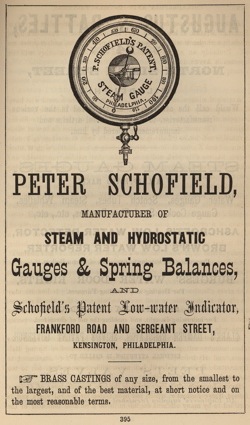
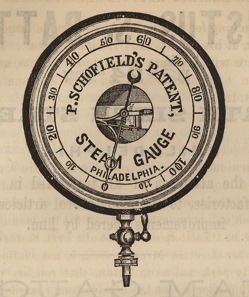
Peter Schofield, Steam & Hydrostatic Gauges & Spring Balances
2327-2333 & 2316-2340 Frankford Road, Philadelphia, PA [buildings on three different blocks, see below]
"Among the ingenious men of Philadelphia there are several who have made a specialty of constructing Steam Gauges and Indicators, for the purpose of testing the true state and condition of the water in Steam Boilers. The most extensive establishment for the manufacture of these invaluable articles in Philadelphia, is that of PETER SCHOFIELD, on Frankford road and Amber streets. Mr. Schofield, in association with William Smith, has recently perfected an invention that renders practicable and efficient the Ball Indicator, which has always been regarded as embodying the true principle of a reliable instrument for testing water in Boilers. Hitherto these balls or copper spheres were imperfect in construction, being liable to sink or collapse; but in Messrs. Schofield & Smith's improvements, all the former objections are obviated. This invention consists in making the ball hollow with an outside communication by means of a cylindrical tube working in a stuffing box. As perfected, this new Indicator consists of a hollow copper sphere, seven and a half inches in diameter, which, floating on the water within the boiler, communicates by means of a bollow tube with a ]ever on the exterior of the boiler, where also a graduated index points out every half inch of water contained in the boiler; and should the water get below the point of safekv, the indicator draws a chain connected with the steam whistle, and gives effective warning of the presence of danger. Indicators may be placed in the office as well as on the boiler, and thus the proprietor, as well as the engineer, may know at any time the true state of the water in the boilers. Mr. Schofield deserves great credit for his perseverance in improving Steam Gauges.
"In connection with his Works, Mr. Schofield has a Brass Foundry for miscellaneous castings. He also manufactures Locomotive Spring Balances, and Hydrostatic Gauges that are adapted for attachment to Hydrostatic Presses, and will indicate a fluid pressure from ten to ten thousand pounds, if required."
—© Freedley, Philadelphia and its Manufactures (1867), pp. 356-358.
Research notes: (Torben Jenk, June 2007)
Schofield is likely to have stood on the triangular plot of ground bounded by Amber Street on the northwest, Frankford Avenue on the southeast, Cumberland Street on the southwest, and Sergeant Street at the northeast point. T. Wilbraham could have taken over the property from Schofield, including the "Machine Shop erected 1844". Research continues.
Hexamer General Survey #673 (1873) "Wilbraham Steam Engine Works, T. Wilbraham & T. Wilbraham & Bros., Philadelphia" shows a cluster of buildings. "Machine Shop erected 1844, Foundry built 1862, Extension of machine shop erected 1873." Undated accessory structures include a "Pattern Store Room" and "Sand Shed."
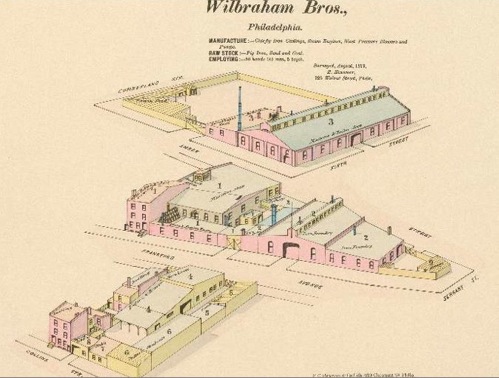
"Wilbraham Steam Engine Works, Wilbraham Bros., Philadelphia" (1879), Hexamer #1423-1424 has a gorgeous birds eye view as well as plan and construction information.
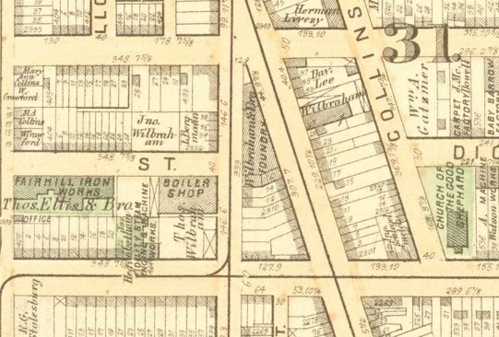
Hopkins Atlas (1875, Plate R), detail: shows the "Wilbraham & Bro. Foundry" on the triangular plot, west (Boiler Shop) and east of Frankford Avenue.
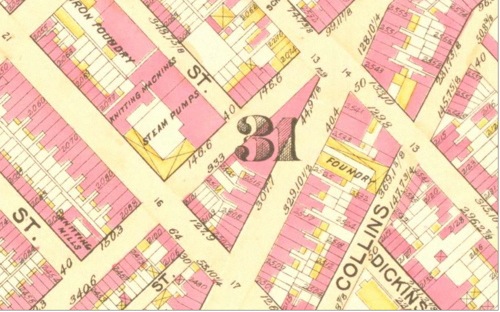
Bromley (1895, Plate 16), detail: no occupant identified. Red is constructed in brick. Yellow is wood frame. Note "Steam Pumps" on the northwest corner of Amber & Cumberland, of brick and frame construction. Foundry east of Frankford is of wood frame.